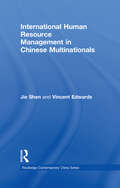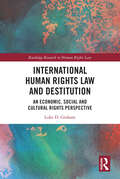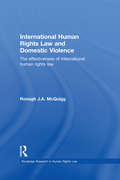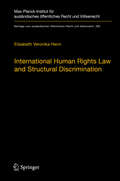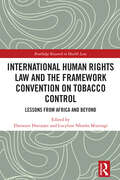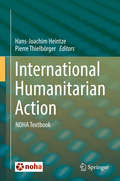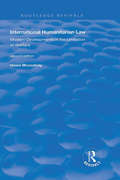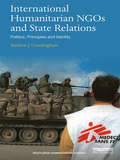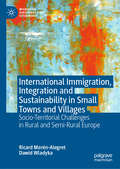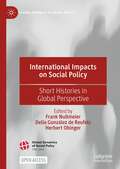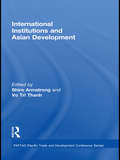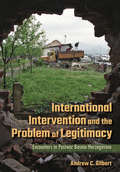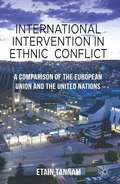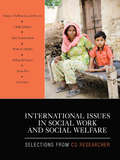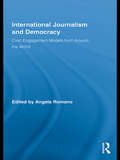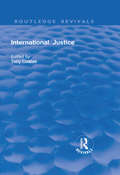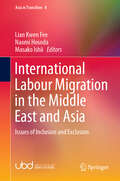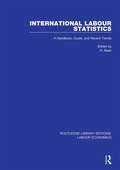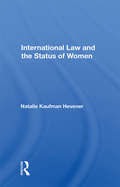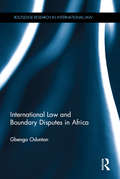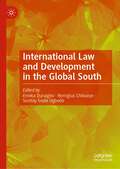- Table View
- List View
International Human Resource Management in Chinese Multinationals (Routledge Contemporary China Series #Vol. 12)
by Jie Shen Vincent EdwardsThe authors explore the degree to which Chinese multinationals have a distinctive 'Chinese' approach to human resource management, in the same way as large Japanese companies are widely regarded as having a special Japanese approach. Based on extensive original research in the subsidiaries of Chinese multinationals outside China, the book examines a wide range of issues related to this key question including the evolution of human resource management in Chinese companies, the internationalization of Chinese business, recruitment and selection, rewards and compensation, performance appraisal, strategic integration, and employee relations. Shen and Edwards give a detailed account of the international human resource management of Chinese multinational enterprises; a topic of increasing significance in understanding global economic affairs.
International Human Rights Law and Destitution: An Economic, Social and Cultural Rights Perspective (Routledge Research in Human Rights Law)
by Luke D. GrahamThis book explores destitution from the perspective of International Human Rights Law and, more specifically, Economic, Social and Cultural Rights. The experience of destitution correlates to the non-realisation of a range of economic, social and cultural rights. However, destitution has not been defined from this perspective. Consequently, the nexus between destitution and the denial of economic, social and cultural rights remains unrecognised within academia and policy and practice. This book expressly addresses this issue and in so doing renders the nexus between destitution and the non-realisation of these rights visible. The book proposes a new human-rights-based definition of destitution, composed of two parts. The rights which must be realised– the component rights – and the level of realisation of these rights which must be met – the destitution threshold – to avoid destitution. This human rights-based understanding of destitution is then applied to a UK case study to highlight the relationship between government policy and destitution, to illustrate how destitution manifests itself, and to make recommendations – founded upon engendering the realisation of economic, social and cultural rights – aimed towards addressing destitution. This book will have global and cross-sectoral appeal to anti-poverty advocates, policy makers, as well as to researchers, academics and students in the fields of human rights law, poverty studies, and social policy.
International Human Rights Law and Domestic Violence: The Effectiveness of International Human Rights Law (Routledge Research in Human Rights Law)
by Ronagh J.A. McQuiggThis innovative book examines the effectiveness of international human rights law, through the case study of domestic violence. Domestic violence is an issue that affects vast numbers of women throughout all nations of the world, but as it takes place between private individuals it does not come within the ambit of the traditional interpretation of human rights law. Ronagh J.A. McQuigg questions whether international human rights law can only be effective in a ‘traditional’ case of human rights abuse or whether it can rise to the challenge of being used in relation to issues such as domestic violence. The book focuses primarily on the question of how international human rights law could be used in relation to domestic violence in the United Kingdom. McQuigg considers recent case law from the European Court of Human Rights on domestic violence and whether the UK courts could use the Human Rights Act 1998 to assist victims of domestic violence. The book goes on to look in detail at the statements of the international human rights bodies on domestic violence, with particular focus on those made by the United Nations Committee on the Elimination of Discrimination against Women and the Special Rapporteur on Violence against Women. The book explores the impact that the statements have had so far on the UK government’s policy in relation to domestic violence and discusses how the statements made by the international human rights bodies could be used more effectively by non-governmental organisations, such as human rights groups and women’s groups.
International Human Rights Law and Protection Against Gender-Based Harm on the Internet
by Maria SjöholmThis book analyses gender-based offences on the Internet from the perspective of international human rights law, interwoven with rights theories and feminist legal theories. It investigates whether international human rights law is applicable in regulating harmful online conduct and speech, with a focus on sexual violence, various forms of harassment, sexist hate speech and harmful pornography. This involves assessing whether gender-based online offences are considered violations of international human rights law and – if they are recognised as such explicitly or by way of interpretation – the extent of state obligations. The book reviews a range of international law sources, such as selected international human rights law treaties, case law, soft-law documents and academic scholarship. The application of general human rights law provisions to the online sphere is evaluated by considering the online/offline coherence of provisions as well as potential gaps, inconsistencies and disadvantages that exist in the regulation of online gender-based offences. The makeup, aim and effect of social spheres, areas of law and legal principles are thus assessed in relation to gender and the Internet. Aspects discussed include the architecture of the Internet, the structure of public international law, the harm principle as employed in domestic law and international human rights law, and the scope of particular rights, mainly involving the freedom of expression and the right to privacy. Working from the premise that the transposition of international human rights law to the Internet must ensure the former’s functionality and effectiveness, the book argues that a contextual application of rights is called for. This requires assessing what is harmful online – including the effects of online speech and conduct - and what are effective means of regulating liability on the Internet. In turn, such assessments require a gender-sensitive approach.
International Human Rights Law and Structural Discrimination: The Example of Violence against Women (Beiträge zum ausländischen öffentlichen Recht und Völkerrecht #280)
by Elisabeth Veronika HennInternational courts and other actors are increasingly taking into account pre-existing social structures and inequalities when addressing and redressing human rights violations, in particular discrimination against specific groups. To date, however, academic legal research has paid little attention to this gentle turn in international human rights law and practice to address structural discrimination. In order to address this gap, this study analyses whether and to what extent international and regional human rights frameworks foresee positive obligations for State parties to address structural discrimination, and, more precisely, gender hierarchies and stereotypes as root causes of gender-based violence. In order to answer this question, the book analyses whether or not international human rights law requires pursuing a root-cause-sensitive and transformative approach to structural discrimination against women in general and to the prevention, protection and reparation of violence against women in particular; to what extent international courts and (quasi)judicial bodies address State responsibility for the systemic occurrence of violence against women and its underlying root causes; whether or not international courts and monitoring bodies have suitable tools for addressing structural discrimination within the society of a contracting party; and the limits to a transformative approach.
International Human Rights Law and the Framework Convention on Tobacco Control: Lessons from Africa and Beyond (Routledge Research in Health Law)
by Ebenezer Durojaye Lucyline Nkatha MurungiThis book reviews the challenges and opportunities in the implementation of the WHO Framework Convention on Tobacco Control (FCTC) at the regional and national levels in Africa. It contains an analysis of the relevant norms and monitoring mechanisms at the regional level, and case studies from selected African and other developing countries. The WHO has noted that tobacco use or exposure to tobacco is a major health risk factor for non-communicable diseases (NCDs). This volume highlights the importance of taking measures to control tobacco use in Africa with a view to preventing these risks. With contributions from experts from the Global South, the book provides a critical analysis of the role that human rights can play in mitigating the impact of tobacco use and NCDs, and the implementation of the FCTC. The book contains a systematic and in-depth analysis of how efforts to realise the right to health under international and regional law can help to address the incidence of tobacco use in the developing world. The collection will be an important resource for academics, researchers and policymakers working in the areas of public health law and international human rights.
International Human Rights: Universalism Versus Relativism (Frontiers of Anthropology #6)
by Alison Dundes RentelnThe universality of international human rights has been an enduring issue. This volume argues that the positions of universalists and cultural relativists are not diametrically opposed and that it is possible to demonstrate, empirically and cross-culturally, the existence of worldwide human rights.
International Humanitarian Action
by Pierre Thielbörger Hans-Joachim HeintzeThis textbook examines a wide range of humanitarian action issues, presented by specialists from different academic fields in five chapters. The respective chapters reflect the five core modules of the International Master Program "International Humanitarian Action" (NOHA), which have been jointly defined by researchers at the NOHA universities and consist of a) Geopolitics in Humanitarian Action, b) Anthropology in Humanitarian Action, c) International and Human Rights Law, d) Public Health and Medicine, and e) Management in Humanitarian Action. The book represents the common basis for teaching at all NOHA universities and aims at providing the knowledge and skills needed to excel in a complexinterdisciplinary and international learning context. It provides in-depthinformation on key international humanitarian principles and values, professional codes of conduct, and the commitment to their implementation in practice.
International Humanitarian Law: Modern Developments in the Limitation of Warfare (Routledge Revivals)
by Hilaire McCoubreyFirst Published in 1998, this book presents an analysis of international humanitarian law, the law governing and seeking to mitigate the conduct of armed conflict. Since the first edition of this work came out in 1990 there have been important developments in the law and, sadly, a continuing experience of armed conflict and the humanitarian crises which it represents. As a result, this is not so much an ‘updating’ as the offering of a new book. International humanitarian law is here taken as coterminous with the jus in bello and covers both its ‘Geneva’ and ‘Hague’ elements dealing, respectively with the humanitarian protection and assistance of victims of armed conflict and the controls and restrictions placed upon methods and means of warfare. The rules and principles of international humanitarian law are presented and analysed in the context of their practical application in warfare, with emphasis upon recent experience. The Work is Primarily dedicated to the law relating to international armed conflict but also includes discussion of the relevant law applicable to non-international and ‘low level’ conflict.
International Humanitarian NGOs and State Relations: Politics, Principles and Identity (Routledge Humanitarian Studies)
by Andrew J. CunninghamInternational Humanitarian NGOs and State Relations: Politics, Principles and Identity examines the often discordant relationship between states and international non-governmental organisations working in the humanitarian sector. INGOs aiming to provide assistance to populations suffering from the consequences of conflicts and other human-made disasters work in the midst of very politically sensitive local dynamics. The involvement of these non-political international actors can be seen as a threat to states that see civil war as a state of exception where it is the government’s prerogative to act outside ‘normal’ legal or moral boundaries. Drawing on first-hand experience of humanitarian operations in contexts of civil war, this book explores how the relationship works in practice and how often clashing priorities can be mediated. Using case studies of civil conflicts in Sri Lanka, Darfur, Ethiopia and Chechnya, this practice-based book brings together key issues of politics, principles and identity to build a ‘negotiation structure’ for analysing and understanding the relationship. The book goes on to outline a research and policy development agenda for INGOs to better adapt politically to working with states. International Humanitarian NGOs and State Relations will be a key resource for professionals and policy makers working within international humanitarian and development operations, as well as for academics and students within humanitarian and development studies who want to understand the relationship between states and humanitarian and multi-mandate organisations.
International Immigration, Integration and Sustainability in Small Towns and Villages: Socio-Territorial Challenges in Rural and Semi-Rural Europe (Migration, Diasporas and Citizenship)
by Ricard Morén-Alegret Dawid WladykaThis book brings small places to the main stage in an exploration of the nature of immigration in rural areas and small towns in Europe. Extending recent efforts to study migration at a sub-national scale, the authors focus their analysis on non-metropolitan areas to consider how globalisation and modernisation processes are experienced at a local level. Morén-Alegret and Wladyka weave themes of livelihood, social participation, justice and equity into human and planetary sustainability debates, drawing on quantitative population data as well as qualitative information on challenges for rural and small town sustainability in four different European countries (Portugal, France, Spain and England).Highlighting the interlinked relationship between rural sustainability, migration and ethnic diversity, this research is a valuable resource for policy-makers and academics alike, with far-reaching implications across geography, sociology, political science, anthropology and environmental sciences.
International Impacts on Social Policy: Short Histories in Global Perspective (Global Dynamics of Social Policy)
by Herbert Obinger Frank Nullmeier Delia González de ReufelsThis open access book consists of 39 short essays that exemplify how interactions between inter- and trans-national interdependencies and domestic factors have shaped the dynamics of social policy in various parts of the world at different points in time. Each chapter highlights a specific type of interdependence which has been identified to provide us with a nuanced understanding of specific social policy developments at discrete points in history. The volume is divided into four parts that are concerned with a particular type of cross-border interrelation. The four parts examine the impact on social policy of trade relations and economic crises, violence, international organisations and cross-border communication and migration. This book will be of interest to academics and postgraduate students in the field of social policy, global history and welfare state research from diverse disciplines: sociology, political science, history, law and economics.
International Institutions and Economic Development in Asia (PAFTAD (Pacific Trade and Development Conference Series))
by Shiro ArmstrongAre international and Asian regional institutions serving the development goals of Asian and Pacific Economies as well they should? The global economy, led by the Asia Pacific region, has undergone immense change and growth. Have the existing institutions and arrangements been able to keep pace with those changes in the global economy? International Institutions and Asian Development tackles these questions and is an essential book for the assessment of regional and international institutions, as well as policy prescriptions for reforming them to ensure they deliver on sustainable, peaceful growth and development in the region. Drawing from papers presented to the 32nd Pacific Trade and Development conference in Hanoi in 2007, the contributions by distinguished authors add to the understanding of the purpose, evolution, relevance and gaps in regional and global institutions and their arrangements. Shiro Armstrong is a Research Fellow at the Crawford School of Economics and Government at the Australian National University. Vo Tri Thanh is Director of the Department for International Economic Integration Studies of the Central Institute of Economic Management in Vietnam
International Intervention and the Problem of Legitimacy: Encounters in Postwar Bosnia-Herzegovina
by Andrew GilbertIn International Intervention and the Problem of Legitimacy Andrew C. Gilbert argues for an ethnographic analysis of international intervention as a series of encounters, focusing on the relations of difference and inequality, and the question of legitimacy that permeate such encounters. He discusses the transformations that happen in everyday engagements between intervention agents and their target populations, and also identifies key instabilities that emerge out of such engagements. Gilbert highlights the struggles, entanglements and inter-dependencies between and among foreign agents, and the people of Bosnia-Herzegovina that channel and shape intervention and how it unfolds.Drawing upon nearly two years of fieldwork studying in postwar Bosnia and Herzegovina, Gilbert's probing analysis identifies previously overlooked sites, processes, and effects of international intervention, and suggests new comparative opportunities for the study of transnational action that seeks to save and secure human lives and improve the human condition.Above all, International Intervention and the Problem of Legitimacy foregrounds and analyzes the open-ended, innovative, and unpredictable nature of international intervention that is usually omitted from the ordered representations of the technocratic vision and the confident assertions of many critiques.
International Intervention in Ethnic Conflict
by Etain TannamThe EU and the UN have become increasingly involved in conflict resolution, yet they are rarely compared systematically. This book focuses on the role of bureaucracies in the European Union (EU) and the United Nations (UN) when dealing with conflict. Tannam's comparative analysis of EU and UN policy-making procedures explores how and why they differ from each other, arguing that the UN Secretariat and the European Commission have autonomy under certain conditions and that reducing explanations of EU and UN policy outcomes to political will, or to the preferences of member states is inaccurate. This unique empirical study, enhanced by interviews with practitioners, will be a valuable resource for scholars of International Relations, Peace Studies and Comparative Politics.
International Issues in Social Work and Social Welfare: Selections From CQ Researcher
by Cq ResearcherWhat is human trafficking, and where does it occur?How have other nations exploited children as child soldiers, and what can be done about it?Have violence and discrimination against women increased or decreased globally over the past decade?The collection of articles in International Issues in Social Work and Social Welfare addresses these questions and many more. The articles encourage lively classroom discussion and debate and bring pressing international issues into the classroom for almost any course across the social work curriculum, as required by the new guidelines set forth by the Council on Social Work Education.About CQ Researcher ReadersIn the tradition of nonpartisanship and current analysis that is the hallmark of CQ Press, CQ Researcher readers investigate important and controversial policy issues. Offer your students the balanced reporting, complete overviews, and engaging writing that CQ Researcher has consistently provided for more than 80 years. Each article gives substantial background and analysis of a particular issue as well as useful pedagogical features to inspire critical thinking and to help students grasp and review key material:A pro/con box that examines two competing sides of a single questionA detailed chronology of key dates and eventsAn annotated bibliography that includes Web resourcesAn outlook section that addresses possible regulation and initiatives from Capitol Hill and the White House over the next 5 to 10 yearsPhotos, charts, graphs, and maps
International Journalism and Democracy: Civic Engagement Models from Around the World (Routledge Research In Cultural And Media Studies #25)
by Angela RomanoThis book examines different models from around the world of how journalism can support deliberation — the processes in which societies recognize and discuss the issues that affect them, appraise the potential responses, and make decisions about whether and how to take action. Authors from across the globe identify the types of journalism that might best assist or even drive deliberative activity in different cultural and political contexts. Case studies from 15 nations spotlight different approaches to deliberative journalism, including strategies that have been sometimes been labeled as public or civic journalism, peace journalism, development journalism, citizen journalism, the street press, community journalism, social entrepreneurism, or other names. Each of the approaches that are described offer a distinctive potential to support deliberative democracy, but the book does not present any of these models or case studies as examples of categorical success. Rather, it explores different elements of the nature, strengths, limitations and challenges of each approach, as well as issues affecting their longer-term sustainability and effectiveness.
International Justice: Principles and Issues (Routledge Revivals Ser.)
by Tony CoatesThis title was first published in 2000: Part of the academic response to the phenomenon of globalization, this text explores the legal and philosophical implications with particular reference to the problem of international justice. Among the issues examined in the book are those dealing with matters of principle and with the philosophical grounding of international justice: is a moral universalism possible? Are the claims of moral universalism reconcilable with those of moral particularism? What kind of moral universalism does international justice entail? How does the concept of right bear upon international justice? Is justice, both distributive and formal, applicable to international relations? Other issues discussed are of a more specific nature: is there a right to development? What is the role of justice in the resolution of conflict? is humanitarian intervention justified? What are the ethical implications of global warming and acid rain?
International Labour Migration in the Middle East and Asia: Issues of Inclusion and Exclusion (Asia in Transition #8)
by Kwen Fee Lian Naomi Hosoda Masako IshiiThe discourse on migration outcomes in the West has largely been dominated by issues of integration, but it is more relevant to view immigration in non-Western societies in relation to practices of exclusion and inclusion. Exclusion refers to a situation in which individuals and groups are usually denied access to the goods, services, activities and resources associated with citizenship. However, this approach has been criticised in relation to gender issues, which are very relevant to the situation of migrants. The authors in this volume address this criticism. Furthermore, when framed within a North–South discourse, it may be potentially ethnocentric to assume that the experience of exclusion is cross-culturally uniform. Indeed, work on migration issues has invariably been conducted within such a discourse. The contributors go beyond this binary discourse of ‘exclusion versus inclusion’ which has dominated migration research. They examine the situation of migrants in the Middle East and Asia as one that encompasses both exclusion and inclusion, addressing related concepts of empowerment, ethnocracy, the feminisation of migration and gendered geographies of power, liberal constraint and multiculturalism, individual agency, migrant-friendly discourses, spaces of emancipation and spaces of insecurity. The book highlights current research in the Arab Gulf states, and examines multiculturalism in Asia more broadly. It will be of particular interest to students and researchers in international labour migration studies in the Middle East and Asia.
International Labour Statistics: A Handbook, Guide, and Recent Trends (Routledge Library Editions: Labour Economics #3)
by R. BeanFirst published in 1989. The oil crises of the 1970s and increasing international competitive pressures had profoundly changed the structure and performance of labour. Analysis of labour markets, and especially international comparisons, can be difficult, given the differences between definitions, scope, coverage of data, methods, presentation, and economic and social influence in different regions. This book is an invaluable guide for users of international labour statistics. It centralizes and co-ordinates, from a range of sources, basic statistical information regarding the labour force for a large number of countries. Individual chapters, by specialists in the particular subject areas, deal with eight key aspects relating to the labour markets of major, developed capitalist countries (OECD countries); working population, unemployment, wages, consumer prices, labour costs, hours of work, trade union membership, and industrial disputes. The book discusses the nature of the data sources and statistical compilations, highlights cross-national trends over the past fifteen years, outlines the inherent difficulties of making such cross-country comparisons, and points out the potential pitfalls of interpretation of which users are often insufficiently aware. The book includes a summary of key labour market data, on an individual country basis, for twenty-four OECD countries and twenty other countries.
International Law And The Status Of Women
by Natalie Kaufman HevenerSince 1945 more than 20 international legal instruments dealing specifically with women have been modified or consummated, reflecting a growing international consensus on issues concerning women's role in society. This book is the first complete collection and examination of this group of documents. Dr. Hevener analyzes each of the agreements and assesses its likely impact on the legal status of women. Categorizing the documents according to their goals, she demonstrates the broad range of economic, social, and political concerns they cover and evaluates contemporary patterns and future needs they reveal. The book includes a table of ratifications organized by country and region.
International Law and Boundary Disputes in Africa (Routledge Research in International Law)
by Gbenga OduntanAfrica has experienced a number of territorial disputes over land and maritime boundaries, due in part to its colonial and post-colonial history. This book explores the legal, political, and historical nature of disputes over territory in the African continent, and critiques the content and application of contemporary International law to the resolution of African territorial and border disputes. Drawing on central concepts of public international law such as sovereignty and jurisdiction, and socio-political concepts such as colonialism, ethnicity, nationality and self-determination, this book interrogates the intimate connection that peoples and nations have to territory and the severe disputes these may lead to. Gbenga Oduntan identifies the major principles of law at play in relation to territorial, and boundary disputes, and argues that the predominant use of foreign based adjudicatory mechanisms in attempting to deal with African boundary disputes alienates those institutions and mechanisms from African people and can contribute to the recurrence of conflicts and disputes in and among African territories. He suggests that the understanding and application of multidisciplinary dispute resolution mechanisms and strategies can allow for a more holistic and effective treatment of boundary disputes. As an in depth study into the legal, socio-political and anthropological mechanisms involved in the understanding of territorial boundaries, and a unique synthesis of an African jurisprudence of international boundaries law, this book will be of great use and interest to students, researchers, and practitioners in African and Public International Law, International Relations, and decision-makers in need of better understanding the settlement of disputes over territorial boundaries in both Africa and the wider world.
International Law and Development in the Global South
by Emeka Duruigbo Remigius Chibueze Sunday Gozie OgbodoThis book provides contributions in international law, development, and international relations from a cross section of jurists and scholars including a justice of the Supreme Court of Nigeria and a former Judge of the International Court of Justice at The Hague. The project, conceived as a festschrift in honor of Professor Christian Okeke, aims to amplify the voices and perspectives that are not often accorded the limelight in international legal discourse. Additionally, the contributors discuss such relevant issues as frozen conflicts in Eastern Europe, counter-terrorism and cyber-security in Central Asia, and judicial contrivance in African countries. Bridging the gap between political science and legal scholarship, the book presents an interdisciplinary perspective on the emergence of an international rule of law and development. It also provides much needed empirical research on the implications of multi-level governance and global legal pluralism for the rule of law beyond the nation state. This book will be highly relevant to scholars, academics, researchers, and students in the fields of international relations, law, and development.
International Law and Violence Against Women: Europe and the Istanbul Convention (Routledge Research in Human Rights Law)
by Vladislava Stoyanova Johanna Niemi Lourdes PeroniThis book offers an in-depth and critical analysis of the Istanbul Convention, along with discussions on its impact and implications. The work highlights the place of the Convention in the landscape of international law and policies on violence against women and equality. The authors argue that the Convention with its emphasis on integrated and comprehensive policies has an important role in promoting equality, but they also note the debates on “genderism” that the Convention has triggered in some member states. The book analyses central concepts of the Convention, including violence, gender and due diligence. It takes up major commitments of the parties to the Convention, including support and services to victims, criminal law provisions and protection of migrant women against violence. The book thus makes a major contribution to the development of national laws, policies and practice. It provides a valuable guide for policy-makers, students and academics in international human rights law, criminal and social law, social policy, social work and gender studies.
International Law and the Israeli-Palestinian Conflict: A Rights-Based Approach to Middle East Peace
by Susan M. AkramThe Israeli-Palestinian conflict has long been intertwined with, and has had a profound influence on, the principles of modern international law. Placing a rights-based approach to the Israeli-Palestinian conflict at the centre of discussions over its peaceful resolution, this book provides detailed consideration of international law and its application to political issues. Through the lens of international law and justice, the book debunks the myth that law is not useful to its resolution, illustrating through both theory and practice how international law points the way to a just and durable solution to the conflict in the Middle East. Contributions from leading scholars in their respective fields give an in-depth analysis of key issues that have been marginalized in most mainstream discussions of the Israeli-Palestinian conflict: Palestinian refugees Jerusalem security legal and political frameworks the future of Palestine. Written in a style highly accessible to the non-specialist, this book is an important addition to the existing literature on the subject. The findings of this book will not only be of interest to students and scholars of Middle Eastern politics, International Law, International Relations and conflict resolution, but will be an invaluable resource for human rights researchers, NGO employees, and embassy personnel, policy staffers and negotiators.
